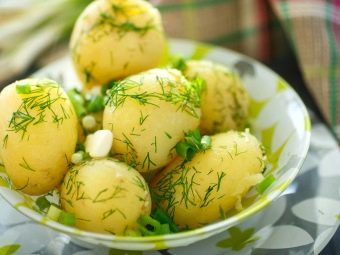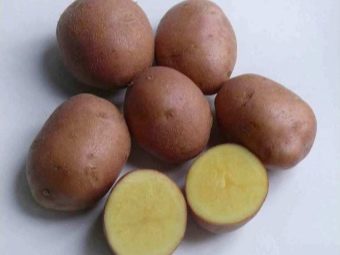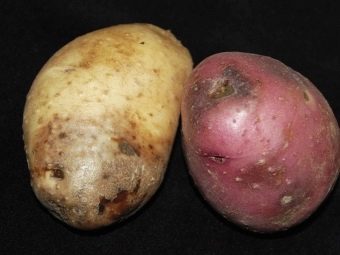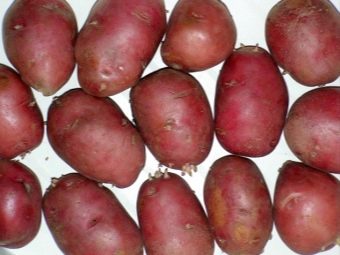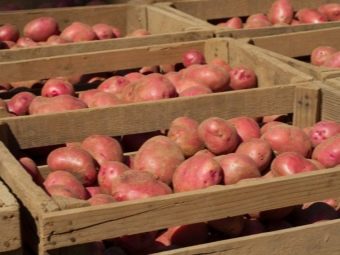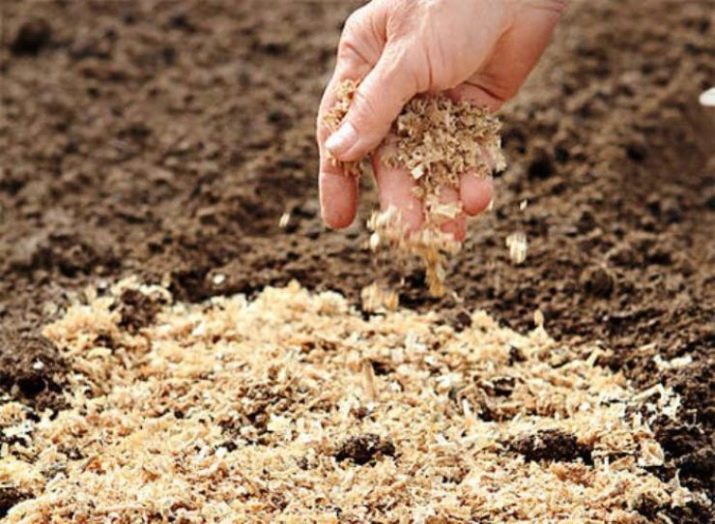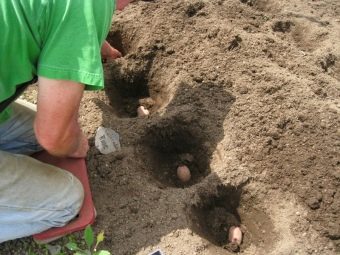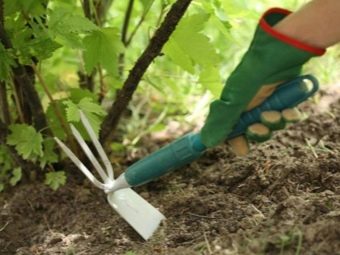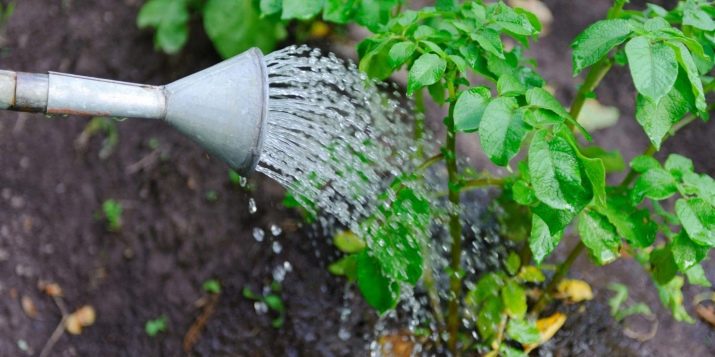Rosalind potatoes: characteristics, planting and care

Potatoes are one of the most popular foods in Russia. There are many varieties of this crop, and each gardener has his own approach to planting and caring for her.In order to ensure maximum yield, it is important not to err in choosing the right variety.
One of the most popular in agriculture is the Rosalind potato of the breeding of the German company Europlant, which has earned the recognition of farmers all over the world due to its delicious taste, high yield and ease of cultivation and subsequent storage.
Description
One of the main properties of this variety is considered to be early ripeness, which is important when grown in areas with a changeable climate, with a predominance of arid or, conversely, rainy weather. Due to this, as well as other qualities, such a variety has an excellent yield - in one season it can produce two yields of 30-60 tons per hectare, and the number of commodity tubers of high uniformity in one bush can reach up to 16 pieces.
In addition, an important feature of the Rosalind potato is the friendly formation of even early production, which is very convenient when harvesting. The mass of each of the tubers reaches 115 g.
This potato variety is also convenient in cultivation, it has:
- the highest frost resistance;
- adaptability to most soil types and varied climates;
- resistant to many common diseases, such as potato cancer, cyst nematode, and all sorts of viruses;
- unpretentiousness in the care - it does not need to be watered often, and in the field it will be enough just one hilling.
But the main thing for potatoes, of course, are consumer qualities, and the Rosalind variety is top notch. It has a pleasant delicate, moderately sweet taste, while slightly boiling soft, does not darken and perfectly keeps its shape during heat treatment, due to which it is ideal for both industrial production of chips and for home frying and cooking (for example, its ability to keep shape often used in the preparation of salads).
Of great value is the fact that due to its dense skin, this type of potato is able to be stored for a long time and at the same time not losing its high taste qualities. Due to the same property, the Rosalind variety is also convenient for transportation over long distances.
Externally, it is a smooth round or oval tuber with a smooth skin, so it is easy to clean; the color of the skin is red, and the flesh is creamy yellow. On the surface there may be small eyes that do not visually spoil the shape. Rosalind potato bushes are semi-upright, with even and open, wavy leaves at the edges of a saturated green color. The buds of the red-purple flowers of this plant often fall to flowering.
Unfortunately, this variety has its drawbacks. One of them is that its tubers and tops are susceptible to such a disease as late blight or brown rot, characterized by leaf darkening or deep black holes in the tubers. That is why such potatoes require additional preventive measures for soil preparation and processing of the plants themselves.
In addition, when grown in clay or sandy soil, yields and quality of tubers may decrease. But it can also be a disadvantage for buyers that the Rosalind variety has a large number of analogs that look like it externally, but at the same time have lower quality characteristics.
Respondents of summer residents about this variety are mostly only positive.
How to plant?
The first step in the cultivation of the Rosalind variety is the preparation of seed potatoes. Ideal tubers weighing 30 grams, the correct form and without damage. At this stage, the potatoes are thoroughly washed, in order to be able to detect darkening, externally similar to dirt, but not washed out with water, as well as other signs of disease. Such products are immediately discarded.As a rule, such a selection is made in the fall, before removing the potatoes for storage, or in early spring.
To stimulate growth, as well as to protect against insects and diseases, seed potatoes are treated with special solutions containing beneficial elements. Growth stimulants provide an increase in yield, insecticide-fungicidal preparations protect the cultivated product from soil pests, wireworms, wire harness, larvae of May Khrushchev, bears and other insects.
For the prevention of all sorts of diseases, and for this class, special attention is paid to the protection against late blight, the so-called dressings are used. For greater reliability, the soil in which the potatoes are to be planted is also treated with special fertilizers.
One of the most important stages of preparation of early ripe potato varieties, including Rosalind, is their preheating and germination, which are usually carried out a month before planting in order to prevent late blight and increase crop yields. To do this, selected and processed tubers are laid out in boxes or special racks and placed in a warm room with a temperature of about + 15 ... 20 degrees and with access to sunlight. Sometimes they are also subjected to a kind of "hardening" - several times for a couple of days the temperature is lowered to + 6 ... 8 degrees.
In order for germination to occur evenly, the tanks with potatoes are periodically rearranged. As a rule, in terms of time, this process takes about 25 days, during which quite large and dense sprouts with root buds appear on the tubers.
Germinated seed potatoes are again checked, this time for the quality of the sprouts. Tubers with white filamentous sprouts, as well as with one or no seedlings, are not suitable for planting. Particular care in handling is required for tubers with sprouts longer than one centimeter, since there is a danger of damaging them during planting.
To accelerate the growth of potato varieties "Rosalind" germination produced by the combined method - approximately on the twenty-first day after laying in boxes, the tubers are moved to humus, compost, peat or sawdust. But also a variant of the combined method is to hide the potatoes with a wet sacking for the remaining period of germination. Such an approach can speed up the harvest by almost a week.
Finally, the germinated tubers are ready for planting. Choosing a suitable time for this, it is more important to start not from the calendar date, but from the readiness of the soil - it should not be cold, otherwise it will slow down the ripening period and reduce the quality of the crop until the seed decays. The optimal soil temperature is + 8 ... 10 degrees. As a rule, they plant potatoes on May holidays, however, depending on the climate, it may be in the middle of April and the end of May.
The most suitable areas for planting this variety in Russia are:
- Central;
- Volgo-Vyatka;
- Central Black Earth;
- North Caucasus;
- East Siberian.
Ideally, the previous cultivated potatoes should be annual legumes, such as lentils and beans. The soil should be soft and well aerated.
Landing is made according to the square-cluster scheme in the direction from the north to the south side. Germinated tubers are placed at a depth of about 10 centimeters at a distance of about 28-35 centimeters between the bushes and with a distance of about 60-75 centimeters between the rows for convenience in further care. As a rule, the first shoots begin on the second week after planting, and in general, the period of ripening takes from 52 to 62 days.
How to care?
Measures for the care of Rosalind potato varieties should be carried out even before germination. For the access of germinating tubers to the air, the soil is regularly loosened and weeded away from weeds. Continue to do so with further care.
The first shoots need hilling, which is carried out twice - after the first appearance of sprouts they are completely covered with earth, then this procedure is repeated after repeated shoots.
During the entire growing period, Rosalind potatoes are useful to feed with mineral or organic fertilizers in a dry or liquid form. It is important to remember that top dressing is carried out only in wet soil. And also when plants reach a height of 20 centimeters, they begin to carry out preventive spraying of the tops of various chemical fungicides containing copper to reduce the risk of phytophlorosis.
When signs of this disease appear, they treat the Bordeaux mixture every 10 days; in general, plants are treated 3-4 times per season.
As a top-dressing, you can use a mixture of superphosphate with potassium sulfate, which crumbles under the bushes, and then loosened into the soil. Liquid fertilizers include nitrogen and phosphate solutions, as well as mullein and diluted bird droppings. With such fertilizers water the space between the rows of bushes.
The variety "Rosalind" needs regular watering, especially after the appearance of the first buds. Water the potatoes in the evening with the calculation of about 3-5 liters of water per bush. In the dry season, during the period of budding and tuberization, watering should be carried out especially carefully.
Harvesting
For better maturation of tubers on the 40-50th day of cultivation, all beginning to die off and dry the tops are completely mowed. It should not be delayed with the harvest, especially of this early ripe variety, otherwise its quantitative and qualitative indicators will noticeably decrease. Drying and warm weather is ideal for digging up potatoes. The optimal harvest time for Rosalind potato varieties is the middle and sometimes the beginning of August or even the end of July. However, the timing may be tolerated in a rainy climate.
The digging is done manually with shovels or forks with flat teeth, as well as by a mechanized method using motor-blocks. It is important to try as much as possible not to damage the tubers, since in the future this will provide more reliable storage.
Dug potatoes are left to dry in a cool dry place for about ten days. During this time, small cuts that could appear during digging also have time to dry. After that, it remains only to sort, discarding the damaged tubers - and the potato "Rosalind" is ready for further storage and use.
As mentioned earlier, this variety is able to produce crops twice in one season. Therefore, after harvesting the first crop, the second planting can be carried out within a week or two or two.
Review the potato "Rosalind", see the following video.



